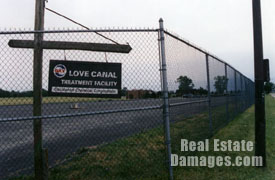Research
Love Canal
Bounded by Colvin, 100th Street, Frontier, & 95th Street
Niagara Falls, New York
Class VIII - Environmental Condition, Hazardous Dump
![]()
 |
Treatment Facility |
The Love Canal was given its name by the 19th century industrialist William T. Love. In 1893, Love started construction of a 10-mile canal from the Lake Erie side of the Niagara River to the Lake Ontario side. The plan was that the 110 foot drop would bypass Niagara Falls and the hydro-power would produce direct current electricity to power the "model city" he envisioned. Only about a mile of the canal was ever dug; the project was abandoned due to the discovery of alternating current, which could travel long distances over power lines. The abandoned canal filled with rain and runoff water, and became a local swimming hole in the summer and an ice rink in the winter. During the period of 1942 to 1953, Hooker Chemical Company and others disposed 21,800 tons of toxic chemicals, including acid chlorides, sulfur compounds, tricholrophenol (TCP), and benzyl alcohol in the canal. The site was later covered with a clay "cap" and sod, and sold for $1 to the local school board. While it was common knowledge that the site harbored dangerous chemical contaminants, the school board built the 99th Street Elementary School directly on top of the old covered canal. In the 1950's, hundreds of middle-class homes were built in the immediate area.
In the 1970's local residents became alarmed at health problems, sludge, fumes and phosphorous rocks that would make a fiery impact when thrown by children. The Love Canal Homeowner's Association became very vocal and the situation received high-profile media attention. On August 7, 1978, President Jimmy Carter declared a "Federal State of Emergency" for the area, and the government offered to pay full-price for all homes in the impacted areas, referred to as Rings 1, 2 and 3. (Ring 1 was the worst area and directly on or near the canal, Ring 2 is not considered fit for residential use, and Ring 3 was the least impacted). The Love Canal Area Revitalization Agency (LCARA) was created to facilitate the buying of over 789 homes. This high-profile incident was the "epicenter" of the explosion of environmental legislation, particularly CERCLA, the $1.6 billion "Superfund Act" which was passed on December 12, 1980. The school was demolished, as were all the homes in the immediate area of the old canal (Ring 1). The canal itself is currently covered and fenced-off, and a remediation unit treats the underlying areas. Many homes to the east (Ring 2) still stand but are mostly abandoned, and there are plans to demolish all of them and build light-industrial buildings. The Lasalle public housing project to the west was demolished and the site is currently vacant. Housing to the north (Ring 3) was largely abandoned, however, many are being refurbished and resold by the LCARA. This area (Ring 3) is currently called Black Creek Village. The homes in Ring 3 sold over recent years at a 20% discount, however, the discount has gradually been reduced and in 1997, 19 years later, they are sold for full value. Homes outside of the EPA study area (Rings 1, 2 and 3) were not considered impacted in value. While hundreds of families made an exodus, seven families in Ring 2 never left the area and still reside there today.
<<Return to Research Page
